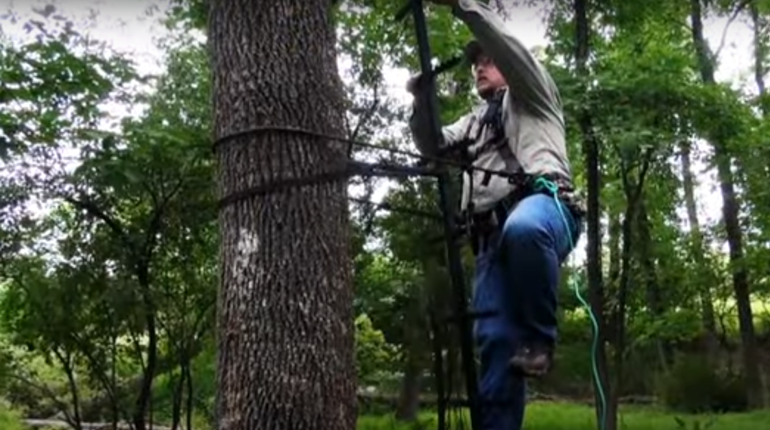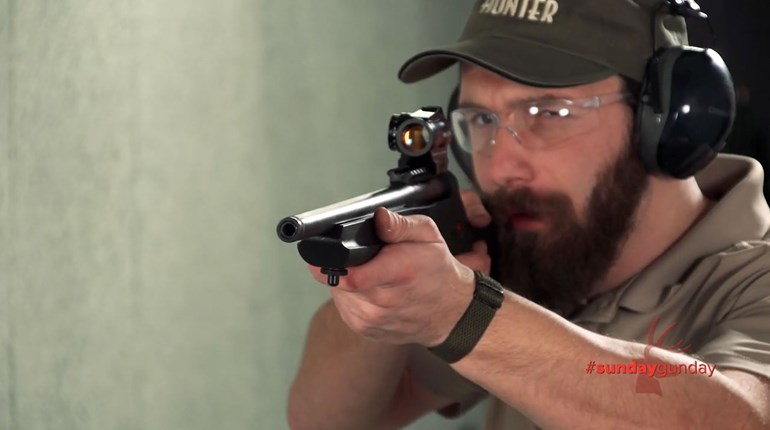In my experience, there aren’t many American hunters who don’t know someone within a first degree of affiliation who has fallen from a treestand, but I am one. No one in my family and no personal friend of mine has fallen. I explained that to my friend Mark over dinner, and he quickly replied, “My brother fell.”
The man climbed into his Pennsylvania bow-stand one fine afternoon … and fell asleep. He somersaulted face-first from his perch, landing on his head and neck and shattering his vertebrae. “When I got the call I rushed to the hospital,” Mark said. “He kept telling me, ‘Mark, I screwed up. I screwed up!’”
The stand was secured just 12 feet above the ground. Unfortunately, Mark’s brother was not secured; though he had it with him, he failed to employ his safety harness. Today, Mark’s brother is a quadriplegic.
Anti-gunners would like us to think that, because firearms are involved, hunting is dangerous. It’s not. When injuries per thousand participants are compared, hunting is safer than almost all sports, even pingpong. Of course most sports don’t involve climbing 12 to 30 feet above the ground in the dark, carefully negotiating the gap between step and stand then remaining above ground through dawn, lunch time, rain, sleet, snow and, often, drowsiness.
Thus the No. 1 hunting-related injury by far remains falls from treestands. This month, as millions of American deer hunters climb in pursuit of their passion, it’s important to remember that fact.
The majority of all falls can be traced to one thing: The victims were not wearing safety harnesses. What eventually occurs varies. Some hunters misstep when transferring from tree to stand, either kicking the platform ajar or missing it entirely. Some lose their footing when rain makes the platform slippery. Some lean too far when spying game or taking aim. Some fall asleep. One of the seemingly most implausible yet real possibilities: The hunter simply forgets where he is and steps off the stand into oblivion.
Included in the list of accidents is treestand “failure,” as commercial stand makers fighting seemingly endless lawsuits will attest. Actual failure of a modern, commercially manufactured treestand usually is not the problem, though. “Failure” often can be traced to misuse of a commercial stand, or improper construction or rotten wood used in a homemade stand … or, in the story Jerry Wydner tells, trouble with a climbing stand.
“In 2000, I was deer hunting with my brother in south Alabama,” says Wydner. “We were using climbers, and I had just gotten up into my tree when I got a call on the radio from John: ‘I need help right away; bring your stand.’
“The base of his climber had fallen to the ground. He wasn’t wearing his harness,” says Wydner. So Jerry shinnied up the tree with his climbing unit and rescued John, and when both hunters returned to earth safely they were visibly shaken. Says Jerry: “I remember looking at John and asking, ‘Why weren’t you wearing your harness?’ And he says to me, ‘Were you wearing yours?’ We both had a harness that morning, and we both got frustrated trying to put it on, like we both had many times before. We sat there that evening and we said, ‘Enough stupidity.’”
In 2000, harnesses were not popular. I know, because I was a hunter who wouldn’t wear the contraptions; the safety they promised didn’t seem worth the effort. For years, I stuck with a simple chest strap in which I wrapped myself after climbing into my stand. But the trouble with such a gadget and such thinking is, 86 percent of all treestand falls occur when the hunter is not in the treestand, says Wydner, a member of the board of the Treestand Manufacturers’ Association (TMA). The reasons behind such a statistic usually involve people falling while they are ascending, descending, or transferring to or from the stand. Waiting until you climb into your stand is the wrong mindset, says Wydner. “The thinking ought to be, ‘How do I stay connected from the ground up?’”
Wydner’s experience launched a process of trial and error that eventually produced the Hunter Safety System (HSS), which today sells more than 100,000 units annually. Its linchpins include a harness, a lineman’s strap for use while climbing or while hanging a stand, a tree strap and a Life Line.
Not all harnesses are created equal, though all may very well save your life (something usually is better than nothing). But not all are simple to employ and not all of them offer protection from the moment you leave the ground. HSS units, whether they’re a plain harness or a harness sewn into a vest, are intuitive to employ; little instruction is needed to get the hang of using them. In fact I think the videos on the company’s website are easier to understand than the written instructions provided with every unit. Nonetheless, read everything included with any unit you buy, and if you have questions call the manufacturer for clarification.
Also vitally important: Stay connected every second you’re above ground.
The “glue” in the HSS system, Wydner says, is the company’s Life Line, a 30-foot length of rope hunters can install above every stand to use from the moment they begin climbing. A three-pack sells for $99, so it costs just $33 to outfit each stand in a network of three, which pretty much dispels any reason to avoid the line on the basis of cost.
Here’s another chilling statistic: 82 percent of all falls that result in death or major injury occur while hunters wear harnesses, says Wydner.
That suggests folks are using chest straps instead of harnesses, or they’re using harnesses incorrectly—or, again, it suggests folks are falling in their harnesses before they strap to a tree. It also suggests that it isn’t the fall that gets you. Hanging for hours does. The problem with chest straps or harnesses that don’t offer relief or a means of escape from the new predicament after a hunter survives a fall but is left hanging is orthostatic shock, or suspension trauma, the development of symptoms like faintness or muscular weakness. Hanging vertically, motionless, induces venous pooling in the legs, which reduces blood flow by 20 percent. According to a report by Jim Shepherd in The Outdoor Wire last year, suspension trauma was suspected as the cause of death of five mountain climbers found dead in their ropes after climbing accidents between 1957 and 1968; in each case, the climbers exhibited no external or internal injuries. In subsequent medical experiments conducted in 1968, according to Shepherd, five volunteers were suspended in parachute harnesses for 30 minutes. During that time, one volunteer lost consciousness. From there, researchers began to home in on suspension trauma as the culprit in fatal accidents where people were found dead in their harnesses and displayed no evident injuries. If you survive a fall and can’t extricate yourself, stay active. Press your feet against the tree and pump your legs to maintain blood flow throughout your body until help arrives. Better yet, equipped with an HSS vest, hunters may use the company’s Suspension Relief strap (included with every unit) to stand in their harness and relieve the effects of venous pooling.
“On my desk,” says Wydner, “I’ve got not quite 400 letters from people who write to say, ‘You saved my life today.’ It’s so terribly humbling to hear somebody talk about the moment in their life that was so profound that it changed their life. I’ve heard grown men cry on the telephone.”
As a member of the TMA, Wydner doesn’t care whether you wear his harness or somebody else’s. Just wear one. “We owe that to those who love us,” he says. “How silly that the passion of our life would take our life.”
10 Treestand Safety Tips
• Always wear a fall-arrest system/full-body harness meeting TMA standards when your feet leave the ground.
• Always use a treestand that meets TMA standards; never use homemade stands or commercially made stands that have been altered.
• Always read and understand all instructions accompanying harnesses and treestands; practice with them before use.
• Never exceed recommended weight limits.
• Always inspect equipment before and after use.
• Always hunt with a buddy nearby when possible. Tell others of your plans.
• Always carry some combination of emergency signal devices: whistle, radio, flare, cell phone.
• Always select the proper tree for use with your treestand.
• Always use a haul line to pull up gear; never climb without two free hands.
• Never hurry.
For more tips, go to tmastands.com.





































